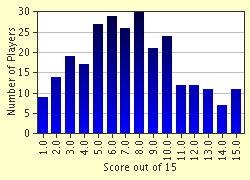Quiz Answer Key and Fun Facts
1. In par'shat Lech Lecha, Avram and a fellow shepherd decided to go their separate ways. This other shepherd allowed greed and lust to warp his better judgment. Avram, knowing it was best for them to go their separate ways, still attempted to maintain peace and said, 'Please let there be no strife between me and you, and between my herdsmen and your herdsmen, for we are kinsmen. Is not all the land before you? Please separate from me: If you go left then I will go right, and if you go right, I will go left.' To whom was Avram talking to? Who was this other shepherd?
2. In par'shat Chayai Sarah, Sarah dies in the very first pasuk. She had lived 127 years. She died in Kiriat-Arbah (the city of four), in the land of Chevron. According to Rashi, what was the significance or foreshadowing of the name Kiriat-Arbah?
3. After Yosef was sold, Judah left his brothers, and met a merchant who introduced him to his daughter. Judah fell in love with this woman. Her name was Shua. Together they bore two kids, Er and Onan. Judah arranged for a beautiful woman named Tamar to marry his firstborn, Er. However Er did something that was wicked in the eyes of Hashem, and Er was killed. By the ancient Jewish law of levirating (marrying the wife of your dead brother), Onan was instructed by Judah to marry Tamar. Unfortunately, Onan did a similar thing to what his brother did, and this too was evil in the eyes of Hashem, and He caused him to die also. What did both brothers do to anger Hashem enough that Hashem would kill them?
4. In Par'shat Ki Sisa, Hashem speaks to Moshe, telling him to take a census of b'nai Yisrael, but there was a problem. The Torah teaches that it is forbidden to count Jews in the ordinary manner, and that when it is necessary to take a census, like it was at this time, the Jews must contribute an item which would be counted instead. What item was each Jew, rich or poor, required to give to Moshe for the purpose of the nation?
5. Here's a TOUGH one! The Biblical word for portion is mentioned three times altogether in three consecutive pesukim. The significance of the number three is that there were three separate gifts or portions of those gifts that the Jews were required to contribute to Hashem, and the building of the Mishkan. What is the Biblical word for portion?
6. Rambam comments that it is asur (forbidden) to eat an animal that was killed in the field, because this deters the Jews from attaining holiness, which Hashem set for His people. According to Rashi, when we come across such meat what should we do with it to show 'gratitude and appreciation'?
7. Upon learning about the red cow (heffer), we understand that it must be COMPLETELY red. In fact, according to Rashi, if even two hairs are a different color, it is disqualified. What one word in the Torah means 'completely', so that we understand that the cow mustn't simply be red, but completely and fully red?
8. In Sefer Bamidbar (the Book of Numbers), two censuses were taken of the number of people all together from each tribe. In Par'shat Bamidbar, a total number is given, but as many years (Parshos Pinchas) passed the total number remained almost identical to the previous number, only slightly less. Find these two places and answer which of the following is the difference in the two numbers.
9. In Par'shat Kedoshim, we are giving many laws regarding many topics (holiness, Shabbat, parents, human relations, dietary laws, etc.). One law says 'Lo Tenachashu'. What is this law forbidding?
10. While an animal with blemishes may not be sacrificed to Hashem, so too a Kohen with blemishes may not perform the service. The Torah describes specific blemishes that would make a Kohen prohibited from making a Korban. They are: Charum, Sharuah, Giben, and Tivulal biEyno. Which of the following is NOT the English translation of one of those blemishes?
11. Unlike most kosher animal groups, this animal group's kashrut laws are identified by a list of names rather than by characteristics.
12. Halacha states that a farmer must complete every area of his field, and leave not one area unharvested, thus preventing anybody from stealing that which has not been harvested.
13. The Torah permits any Jewish man or woman to adopt voluntarily the status of a Nazir.
14. Miriam and Aaron condemned Moses for having married a Cushite woman (Tzipora). Hashem immediately intervened. For their harsh judgement of Moses, Hashem afflicted Miriam with leprosy.
From Hashem's intervention, Rambam points out one quality that applied to Moses.
15. What is the name for numerical coding for Hebrew words?
Source: Author
zakcos
This quiz was reviewed by FunTrivia editor
nerthus before going online.
Any errors found in FunTrivia content are routinely corrected through our feedback system.


